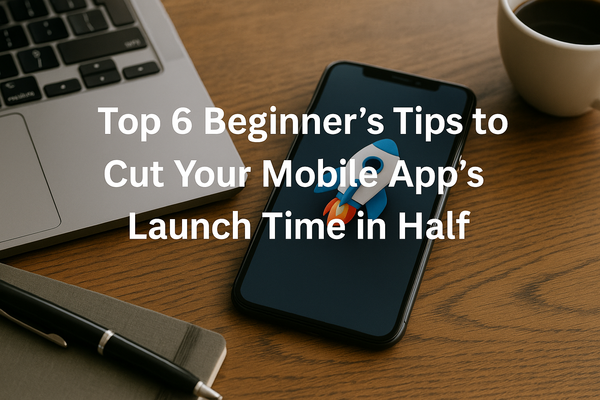Notifications
ALL BUSINESS
COMIDA
DIRECTORIES
ENTERTAINMENT
FINER THINGS
HEALTH
MARKETPLACE
MEMBER's ONLY
MONEY MATTER$
MOTIVATIONAL
NEWS & WEATHER
TECHNOLOGIA
TV NETWORKS
VIDEOS
VOTE USA 2026/2028
INVESTOR RELATIONS
COMING 2026 / 2027
ALL BUSINESS
COMIDA
DIRECTORIES
ENTERTAINMENT
FINER THINGS
HEALTH
MARKETPLACE
MEMBER's ONLY
MONEY MATTER$
MOTIVATIONAL
NEWS & WEATHER
TECHNOLOGIA
TV NETWORKS
VIDEOS
VOTE USA 2026/2028
INVESTOR RELATIONS
COMING 2026 / 2027
 Eira Wexford -
Jun 10 -
Technology -
Flutter app launch steps
Mobile Development
App Launch
MVP
Agile
App Release
-
116 views -
0 Comments -
0 Likes -
0 Reviews
Eira Wexford -
Jun 10 -
Technology -
Flutter app launch steps
Mobile Development
App Launch
MVP
Agile
App Release
-
116 views -
0 Comments -
0 Likes -
0 Reviews

In the dynamic and fiercely competitive world of mobile applications, speed to market isn't just an advantage; it's often a necessity for survival, especially for beginners and startups. A lengthy development cycle can mean missing out on emerging trends, allowing competitors to gain traction, and even seeing your initial concept become outdated before it ever reaches users. Cutting your mobile app's launch time in half, without sacrificing quality, is an ambitious but achievable goal with the right strategies.
For anyone venturing into Mobile App Development, these initial stages can feel overwhelming. However, by focusing on a few critical tweaks and smart approaches, even beginners can significantly accelerate their path to launch. These tips prioritize efficiency, reduce common pitfalls, and set the stage for a more agile and successful development journey.
Here are 6 beginner-friendly tips to dramatically cut your mobile app's launch time in half:
The most common trap for beginners is trying to build an app with every imaginable feature. This "everything but the kitchen sink" approach inevitably leads to bloated timelines, budget overruns, and delayed launches. An MVP is the simplest version of your app that delivers core value to users.
How it cuts launch time:
Reduced Scope: By focusing only on the absolute essential features that solve a single, critical user problem, you drastically reduce the amount of design, development, and testing work required. This means less code to write and fewer elements to perfect.
Faster Development: With a smaller scope, your initial Mobile App Development efforts are concentrated on the most important functionalities, allowing you to build and refine them much quicker.
Early User Feedback: Launching an MVP quickly allows you to get real user feedback from your target audience. This is invaluable for validating your core idea and understanding what users truly want, guiding future development and preventing wasted effort on features nobody needs.
Lower Risk: A smaller initial investment in time and money means less risk. If the MVP doesn't quite hit the mark, it's easier to pivot or refine the concept.
Deciding whether to build natively (separate codebases for iOS and Android) or cross-platform can heavily influence your launch speed. For beginners aiming for a rapid launch on both major mobile operating systems, cross-platform frameworks are often the answer.
How it cuts launch time:
Single Codebase: Frameworks like React Native, Flutter, or Xamarin allow you to write one set of code that can be deployed on both iOS and Android. This instantly halves the development effort compared to building two separate native apps.
Code Reusability: Not only the core logic but also many UI components can be reused across platforms, saving significant time in coding, testing, and debugging.
Unified Teams: Your Mobile App Development team can work on a single codebase, streamlining communication and collaboration, which further accelerates the process.
Faster Iteration: Updates and new features can be rolled out simultaneously to both platforms, ensuring consistency and faster delivery post-launch as well.
For beginners, testing might seem like a daunting task, but even basic automation can dramatically speed up your development cycle by catching bugs early and consistently. Manual testing, while necessary for some aspects, can become a significant bottleneck.
How it cuts launch time:
Catch Bugs Early: Automated tests run every time you make a change to your code. This "shift-left" approach means bugs are identified almost immediately, where they are far cheaper and quicker to fix than when discovered much later in the development process.
Faster Regression Checks: As your app grows, you need to ensure new features don't break existing ones. Automated regression tests do this instantly, eliminating the need for lengthy manual retesting of the entire app with every update.
Consistent Quality: Automated tests ensure a consistent level of quality throughout the Mobile App Development process, reducing surprises and last-minute scrambling before launch.
Increased Confidence: Knowing that your core functionalities are constantly being validated by automated tests allows your team to develop new features with greater confidence and speed.
The app store submission process for both Apple's App Store and Google Play Store can be a significant source of delays. Ignorance of guidelines often leads to rejections, forcing costly and time-consuming rework.
How it cuts launch time:
Avoid Rejection Rework: By familiarizing yourself with Apple's App Store Review Guidelines and Google Play's Developer Program Policies from the very beginning of your Mobile App Development project, you can design and build your app to comply from the outset. This prevents common rejection reasons like privacy issues, incomplete features, or misleading content.
Prepare Metadata Proactively: Gather all necessary assets (app icon, screenshots, video previews, compelling descriptions, keywords, privacy policy URL) well in advance. Preparing these elements alongside development, rather than last-minute, saves crucial time.
Understand Submission Tools: Get acquainted with tools like Apple's App Store Connect and Google Play Console. Even for beginners, understanding the submission flow and required fields can prevent errors and speed up the final deployment phase.
Leverage Beta Testing Tools: Use Apple's TestFlight or Google Play's internal/closed testing tracks to distribute beta versions to testers. This helps catch bugs and gather feedback in a controlled environment before official submission, reducing the likelihood of public issues.
Scope creep – the uncontrolled expansion of project requirements – is a silent killer of launch timelines. It happens when new ideas are constantly added, stretching the project beyond its initial bounds.
How it cuts launch time:
Focused Development: By strictly adhering to your MVP definition and prioritizing only the features absolutely critical for the first launch, your Mobile App Development team remains highly focused. This prevents distractions and ensures resources are directed where they matter most.
"Must-Have" vs. "Nice-to-Have": Learn to differentiate between features that are essential for the app's core functionality (must-haves) and those that can wait for future updates (nice-to-haves). Be ruthless in deferring non-essential features.
Clear Vision: A clear, concise initial vision prevents confusion and allows the team to build directly towards that goal without getting sidetracked by additional functionalities.
Regular Review: Conduct regular reviews of your feature list. If a new idea comes up, put it in a "future releases" backlog instead of immediately integrating it into the current launch plan.
Traditional long-cycle development (waterfall method) is often too slow and inflexible for mobile apps. Adopting a more agile approach, even in its simplest form, can dramatically accelerate your learning and delivery.
How it cuts launch time:
Short Sprints: Break your Mobile App Development into short, manageable cycles, typically 1-2 weeks long, called "sprints." At the end of each sprint, you should have a working, tested piece of the app, no matter how small.
Continuous Feedback: With short sprints, you get frequent opportunities to review progress, test features, and gather feedback, both internally and from early users. This allows you to quickly identify and fix issues or adjust direction, preventing major rework later.
Adaptability: The mobile market changes rapidly. Agile methodologies promote flexibility, allowing you to adapt to new information, user needs, or market shifts without derailing the entire project.
Consistent Progress: Seeing tangible, working parts of the app delivered every few weeks keeps momentum high and provides a clear picture of progress towards launch.
For beginners in Mobile App Development, the journey to launch can seem daunting, but it doesn't have to be excessively long. By strategically applying these six fundamental tips – focusing on an MVP, wisely choosing cross-platform tools, embracing basic automated testing, mastering app store guidelines early, rigorously prioritizing features, and adopting an agile, iterative workflow – you can significantly streamline your development process. These aren't just shortcuts; they are best practices that lead to faster, more efficient, and ultimately more successful app launches, setting a strong foundation for future growth.
